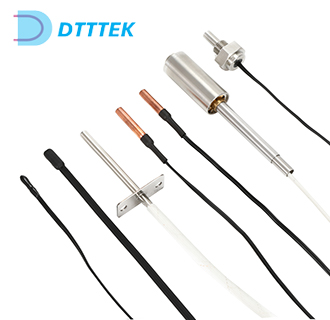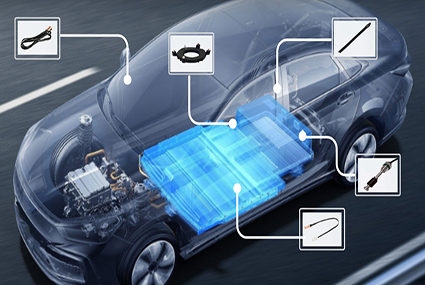Let’s explore the critical role of thermistors in electric vehicles, including their function in battery management, motor protection, and charging safety.
Thermistors are very important in electric vehicles (EVs) because they help keep track of temperature. These small, temperature-sensitive devices are essential for ensuring electric vehicles’ safe and efficient functioning. By monitoring and regulating temperature in various components, thermistors help prevent overheating, improve battery performance, and enhance overall vehicle efficiency. As the automotive industry continues to transition towards electric vehicles, thermistors will remain an indispensable component in the future of sustainable transportation. Here’s a close look at what they do and how they work:

Key Functions of Thermistors in Electric Vehicles
Battery Management Systems (BMS)
- Temperature Monitoring: Thermistors are commonly used in electric vehicle battery packs to check the temperature of each cell. Lithium-ion batteries work best at certain temperatures, so thermistors help keep them at the right temperature to last longer and perform well.
- Thermal Management: If the battery gets too hot, the BMS can use temperature sensors to turn on cooling systems or lower power to prevent overheating. On the other hand, if it gets too cold, the system may start warming up to work well.
- Safety: Getting too hot or cold can damage the battery or cause fires. Thermistors help stop these problems by turning on the right heating or cooling systems.
- Performance: Keeping the battery at the right temperature helps it work better and last longer.
Electric Motor and Inverter Protection
- Motor Temperature Monitoring: Thermistors are placed in the wires and casing of electric motors to check their temperature. Getting too hot can damage the insulation and damage the motor, so the thermistor data helps control the cooling to avoid motor failures.
- Inverter Temperature Control: Inverters change the motor’s DC power from the battery into AC power. They create heat while they work. Thermistors check and manage the inverter’s temperature, keeping it working well and stopping it from overheating.
Charging System Safety
- Temperature Sensing During Charging: Thermistors check the temperature of the battery and charging parts while charging. If it gets too hot, charging can be slowed down or stopped to avoid overheating and danger.
- Connector Temperature Monitoring: During fast charging, special sensors called thermistors check the temperature of connectors. This helps prevent them from getting too hot and keeps charging safe.
Climate Control Systems
- Cabin Temperature Regulation: Electric vehicles (EVs) use thermometers to check the temperature inside the cabin. This information controls heating, cooling, and airflow systems, ensuring passengers feel comfortable using energy wisely.
- Battery Cooling/Heating Systems: Thermistors help control the battery’s temperature, keeping it at the best level for good performance and a long life.
Thermal Management of Power Electronics
- Temperature Monitoring of Power Electronics: Power electronics, like converters and controllers, create a lot of heat. Thermistors check these parts’ temperature to ensure they stay safe and don’t get damaged, which helps them work well.
Safety and Reliability
- Overheat Protection: Thermistors help protect against overheating in parts like the battery, motor, and electrical systems. They start safety measures if the temperature goes too high.
- System Efficiency: Thermistors provide correct temperature information, which helps improve the efficiency of electric vehicle (EV) systems. This makes parts last longer and improves the vehicle’s overall performance.
Types of Thermistors Used in Electric Vehicles
Thermistors in electric vehicles (EVs) are important for checking and managing temperature in different systems. Two kinds of thermistors are mainly used in electric vehicles (EVs). Each type has special features that make it good for different jobs:

Negative Temperature Coefficient (NTC) thermistors
NTC thermistors are devices that have less resistance when the temperature goes up. This opposite connection helps them give accurate temperature readings, making them great for situations where monitoring and controlling temperature is very important.
Aplicativo
- Battery Management Systems (BMS)
- Monitoring battery cell temperatures
- Ensuring a safe operating temperature range
- Electric Motor Temperature Monitoring
- Monitoring motor windings and housing temperatures
- Preventing motor damage from overheating
- Power Electronics Temperature Control
- Monitoring inverters, converters, and other power electronics
- Maintaining efficiency and reliability
Vantagens
- High sensitivity to temperature changes
- Wide operational temperature range
- Precise temperature monitoring
Positive Temperature Coefficient (PTC) thermistors
PTC thermistors have a resistance that goes up when the temperature gets higher. This feature makes them good for use in situations where it’s important to prevent too much current and to control themselves automatically.
Aplicativo
- Overcurrent Protection
- Limiting current flow during overcurrent conditions
- Protecting circuits from damage
- Heating Elements
- Used in-cabin heating systems or battery warmers
- Providing self-regulating heating
Vantagens
- Self-regulating temperature control
- Enhanced safety through overcurrent protection
- Ideal for automatic temperature regulation
Surface-Mount Device (SMD) Thermistors
Aplicativo
- Temperature Monitoring of Electronic Components
- Used in electronic control units (ECUs)
- Monitoring temperatures of microcontrollers, power modules, and sensors
Vantagens
- Compact size for space-constrained areas
- High reliability and stable performance
- Suitable for high-density electronic assemblies
The Future of Thermistors in Electric Vehicles
As electric vehicles (EVs) get better and smarter, thermistors will still be very important. They help keep the vehicles safe, efficient, and working well. Here are some possible future uses of thermistors in electric vehicles (EVs):
1. Advancements in Materials and Manufacturing
Nanotechnology:
Creating new tiny temperature sensors could make them more sensitive and quicker to respond, helping us measure and control temperature more accurately.
Flexible thermistors:
These can be added to flexible battery packs or other parts, improving electric vehicles’ (EVs) performance and design.
2. Integration with AI and Machine Learning
Predictive maintenance:
Thermistors and AI algorithms can help predict possible battery or motor problems by looking at temperature trends and other information. This allows for early maintenance and less downtime.
Smart temperature control:
AI can help adjust the temperature of different parts in electric vehicles (EVs), making them work better and last longer.
3. Wireless and Remote Monitoring
Wireless thermistors:
New improvements in wireless technology may allow for monitoring thermistors from a distance, giving fleet managers or vehicle owners immediate data.
Wireless updates:
Software updates for thermistor systems can be sent without wires, making sure electric vehicles (EVs) have the newest features and improvements.
Conclusão
Thermistors are important in electric cars because they help keep things safe, work well, and run reliably. They provide important temperature information that helps keep delicate parts safe, improve the vehicle’s performance, and make it safer overall. Need further information? We’re here to assist you in your next project.
With our research lab and commitment to excellence, we offer a wide range of products tailored to meet the diverse needs of automotive, robotics, smart home, and other industries. Experience the power of precision temperature control with DTTTEK. Let’s build a brighter future together.


